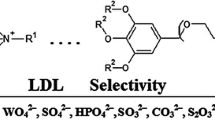Summary
Recently, it was reported that the determination of a number of relevant inorganic anions in waters is achieved without problems by ion-chromatographic techniques. For this application special spherical high-capacity anion exchangers based on a silica gel support matrix were developed. Aqueous phthalic or salicylic acid buffer solutions with higher ion strength were used as mobile phase, and the detectors (RI-, UV- and conductivity detector) were connected directly to the ion-exchange column. The sensitivities of RI-, reduced UV-absorbance- and nonsuppressed conductivity detection were compared but significant differences between various detection principles were not observed. For this reason, a conventional HPLC instrumentation can be used without modification for the determination of inorganic anions in aqueous samples.
However, the ion-chromatographic determination of inorganic anions in fatty products or proteins often involves problems which arise in insufficient separations of inorganic anions and interfering substances when ion-exchange columns are used. In this case better results are obtained by application of ion-pair chromatography on reversed-phase columns. It is shown, that the decisive advantage of ionpair chromatography consists in a wider variability of the Chromatographic parameters. Ion-pair chromatography includes the possibility to vary both the stationary phase and the modifier in such a manner that resulting chromatographic conditions are adapted especially to the analytical problem. Thus, this technique is well suitable for the rapid, precise and sensitive determination of inorganic anions in food.
Zusammenfassung
Neuere Publikationen zeigen, daß relevante anorganische Anionen in Wässern problemlos mit Hilfe der Ionen-Chromatographie bestimmt werden können. Zu diesem Zweck wurden spezielle Anionenaustauschersäulen relativ hoher Austauscherkapazität auf Kieselgelbasis entwickelt. Als mobile Phase bewährten sich Phthalsäure- bzw. Salicylsäurepuffer hoher Ionenstärke, wobei die Detektoren (RI-, UV- und Leitfähigkeitsdetektor) direkt an die Ionenaustauschersäule angeschlossen wurden. Ein Vergleich der Nachweisempfindlichkeiten von RI-, indirekter UV- und Leitfähigkeitsdetektion ergab keine signifikanten Unterschiede, so daß anorganische Anionen in wäßrigen Proben mit einer herkömmlichen HPLC-Ausrüstung bestimmt werden können.
In protein- bzw. fettreichen Lebensmitteln ist die ionen chromatographische Bestimmung anorganischer Anionen jedoch mit Problemen verbunden, denn Ionenaustauschersäulen erweisen sich oft als nicht genügend leistungsfähig, anorganische Anionen und Störsubstanzen ausreichend zu trennen. In solchen Fällen liefert die Ionenpaar-Chromato-graphie an Umkehrphasen, deren entscheidender Vorteil eine größere Variabilität der chromatographischen Parameter ist, weitaus bessere Resultate. Sie bietet die Möglichkeit, stationäre Phase und Modifier so zu verändern, daß die jeweiligen chromatographischen Bedingungen dem analytischen Problem optimal angepaßt sind, so daß eine schnelle, genaue und empfindliche Bestimmung anorganischer Anionen in Lebensmitteln gelingt.
Similar content being viewed by others
Literatur
Lebensmittelrecht-Textsammlung. C. H. Beck'sche Verlagsbuchhandlung, München, Stand: 1. 8. 1983
Amtliche Sammlung von Untersuchungsverfahren nach § 35 LMBG. Beuth-Verlag GmbH, Berlin
Deutsche Einheitsverfahren zur Wasseruntersuchung. Verlag Chemie, Weinheim Deerfield Beach (Florida) Basel
Jansen KH (1978) GIT, Fachz Lab 22:1062–1071
Pohl CA, Johnson EL (1980) J Chromatog Sci 18: 442–452
Firmenschrift: HPLC, Macherey-Nagel, Düren
Schwedt G (1984) Ionen-Chromatographie. Vogel-Verlag, Würzburg
Vonk N (1984) Eur Spectrosc News 53:25–27
Heisz O (1983) GIT, Fachz Lab 27:596–600
Small H, Miller TE (1982) Anal Chem 54:462–469
Cochrane RA, Hillmann DE (1982) J Chromatogr 241:392–394
Small H, Stevens TS, Baumann WC (1975) Anal Chem 47:1801–1809
Weiß J(1983) CLB, Chemie Labor Betrieb 34:342–345
Kamiura T, Tanaka M (1979) Anal Chim Acta 110:117–122
Gerritse RG (1979) J Chromatogr 171:527–529
Thayer JR, Huffacker RC (1980) Anal Biochem 102:110–119
Leuenberger U, Gauch R, Rieder K, Baumgartner E (1980) J Chromatogr 241:392–394
Cortes HJ (1982) J Chromatogr 234:517–520
Oikawa K, Saito H, Sakazume S (1982) Bunseki Kagaku 31:251–255
Firmenschrift: Waters ™-ILC-Series Ion/Liquid Chromatographs, Waters Associates, Milford (USA)
Schmidt B, Schwedt G (1984) Dtsch Lebensm Rdsch 80:137–140
Reeve RN (1979) J Chromatogr 177:393–397
Molnar I, Knauer H, Wilk D (1980) J Chromatogr 201:225–240
Skelly NE (1982) Anal Chem 54:712–715
Kok SH, Buckle KA, Wootton M (1983) J Chromatogr 260: 189–192
Luckas B (1984) Fresenius Z Anal Chem 318:428–433
Horvath C, Melander W, Molnar I (1976) J Chromatogr 125: 129–156
Kissinger PT (1977) Anal Chem 49:883
Hoffmann NE, Liao JC (1977) Anal Chem 49:2231–2234
Bidlingmeyer BA, Denning SN, Price WP, Sachok B, Petrusek M (1979) J Chromatogr 186:419–434
Dreux M, Lafosse M, Pequignot M (1982) Chromatographia 15:653–656
Author information
Authors and Affiliations
Additional information
Vortrag anläßlich des Symposiums Anorganische Anionenanalytik, Regensburg, 19.–21. 9. 1984
Rights and permissions
About this article
Cite this article
Luckas, B. Bestimmung anorganischer Anionen in Lebensmitteln mit Hilfe der Ionen-Chromatographie. Z. Anal. Chem. 320, 519–524 (1985). https://doi.org/10.1007/BF00479824
Received:
Published:
Issue Date:
DOI: https://doi.org/10.1007/BF00479824




